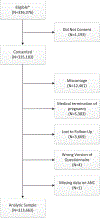Trends of antenatal care during pregnancy in low- and middle-income countries: Findings from the global network maternal and newborn health registry
- PMID: 31005357
- PMCID: PMC7027164
- DOI: 10.1053/j.semperi.2019.03.020
Trends of antenatal care during pregnancy in low- and middle-income countries: Findings from the global network maternal and newborn health registry
Abstract
Background: Antenatal care (ANC) is an important opportunity to diagnose and treat pregnancy-related complications and to deliver interventions aimed at improving health and survival of both mother and the infant. Multiple individual studies and national surveys have assessed antenatal care utilization at a single point in time across different countries, but ANC trends have not often been studied in rural areas of low-middle income countries (LMICs). The objective of this analysis was to study the trends of antenatal care use in LMICs over a seven-year period.
Methods: Using a prospective maternal and newborn health registry study, we analyzed data collected from 2011 to 2017 across five countries (Guatemala, India [2 sites], Kenya, Pakistan, and Zambia). Utilization of any ANC along with use of select services, including vitamins/iron, tetanus toxoid vaccine and HIV testing, were assessed. We used a generalized linear regression model to examine the trends of women receiving at least one and at least four antenatal care visits by site and year, controlling for maternal age, education and parity.
Results: Between January 2011 and December 2017, 313,663 women were enrolled and included in the analysis. For all six sites, a high proportion of women received at least one ANC visit across this period. Over the years, there was a trend for an increasing proportion of women receiving at least one and at least four ANC visits in all sites, except for Guatemala where a decline in ANC was observed. Regarding utilization of specific services, in India almost 100% of women reported receiving tetanus toxoid vaccine, vitamins/iron supplementation and HIV testing services for all study years. In Kenya, a small increase in the proportion of women receiving tetanus toxoid vaccine was observed, while for Zambia, tetanus toxoid use declined from 97% in 2011 to 89% in 2017. No trends for tetanus toxoid use were observed for Pakistan and Guatemala. Across all countries an increasing trend was observed for use of vitamins/iron and HIV testing. However, HIV testing remained very low (<0.1%) for Pakistan.
Conclusion: In a range of LMICs, from 2011 to 2017 nearly all women received at least one ANC visit, and a significant increase in the proportion of women who received at least four ANC visits was observed across all sites except Guatemala. Moreover, there were variations regarding the utilization of preventive care services across all sites except for India where rates were generally high. More research is required to understand the quality and influences of ANC.
Keywords: Antenatal care; Low-middle income countries; Maternal health.
Copyright © 2019. Published by Elsevier Inc.
Figures






Similar articles
-
A prospective observational description of frequency and timing of antenatal care attendance and coverage of selected interventions from sites in Argentina, Guatemala, India, Kenya, Pakistan and Zambia.Reprod Health. 2015;12 Suppl 2(Suppl 2):S12. doi: 10.1186/1742-4755-12-S2-S12. Epub 2015 Jun 8. Reprod Health. 2015. PMID: 26063483 Free PMC article.
-
The quality-coverage gap in antenatal care: toward better measurement of effective coverage.Glob Health Sci Pract. 2014 Apr 8;2(2):173-81. doi: 10.9745/GHSP-D-13-00176. eCollection 2014 May. Glob Health Sci Pract. 2014. PMID: 25276575 Free PMC article.
-
Contents of antenatal care services in Afghanistan: findings from the national health survey 2018.BMC Public Health. 2023 Dec 11;23(1):2469. doi: 10.1186/s12889-023-17411-y. BMC Public Health. 2023. PMID: 38082286 Free PMC article.
-
Number of tetanus toxoid injections before birth and associated factors among pregnant women in low and middle income countries: Negative binomial poisson regression.Hum Vaccin Immunother. 2024 Dec 31;20(1):2352905. doi: 10.1080/21645515.2024.2352905. Epub 2024 May 21. Hum Vaccin Immunother. 2024. PMID: 38772729 Free PMC article. Review.
-
Evolution and determinants of antenatal care services utilization among women of reproductive age in Rwanda: a scoping review.BMC Health Serv Res. 2024 Dec 21;24(1):1636. doi: 10.1186/s12913-024-12038-0. BMC Health Serv Res. 2024. PMID: 39709445 Free PMC article.
Cited by
-
Factors associated with home delivery in rural Sindh, Pakistan: results from the global network birth registry.BMC Pregnancy Childbirth. 2022 Mar 8;22(1):192. doi: 10.1186/s12884-022-04516-2. BMC Pregnancy Childbirth. 2022. PMID: 35260085 Free PMC article.
-
Postnatal care education in health facilities in Accra, Ghana: perspectives of mothers and providers.BMC Pregnancy Childbirth. 2020 Nov 4;20(1):664. doi: 10.1186/s12884-020-03365-1. BMC Pregnancy Childbirth. 2020. PMID: 33148197 Free PMC article.
-
Assessing mobile phone access, usage, and willingness among women to receive voice message-based mobile health intervention to improve antenatal care attendance in district Thatta, Sindh, Pakistan.Reprod Health. 2020 Jul 6;17(1):104. doi: 10.1186/s12978-020-00956-1. Reprod Health. 2020. PMID: 32631370 Free PMC article.
-
Do empowered women receive better quality antenatal care in Pakistan? An analysis of demographic and health survey data.PLoS One. 2022 Jan 6;17(1):e0262323. doi: 10.1371/journal.pone.0262323. eCollection 2022. PLoS One. 2022. PMID: 34990479 Free PMC article.
-
Knowledge, attitudes, practices, and influencing factors of anxiety among pregnant women in Wuhan during the outbreak of COVID-19: a cross-sectional study.BMC Pregnancy Childbirth. 2021 Jan 25;21(1):80. doi: 10.1186/s12884-021-03561-7. BMC Pregnancy Childbirth. 2021. PMID: 33494723 Free PMC article.
References
-
- Robinson M, Pennell CE, McLean NJ, Tearne JE, Oddy WH, Newnham JP. Risk perception in pregnancy. Eur Psychol. 2015;20:120–127.
-
- WHO, UNICEF. Trends in maternal mortality: 1990–2015: estimates from WHO, UNICEF, UNFPA, World Bank Group, and the United Nations Population Division, WHO, UNICEF; 2015.
-
- Blencowe H, Cousens S, Jassir FB, et al. National, regional, and worldwide estimates of stillbirth rates in 2015, with trends from 2000: a systematic analysis. Lancet Global Health. 2016;4(2):e98–e108. - PubMed
-
- WHO. WHO Recommendations on Antenatal Care for a Positive Pregnancy Experience. World Health Organization; 2016. - PubMed
Publication types
MeSH terms
Grants and funding
LinkOut - more resources
Full Text Sources
Medical

